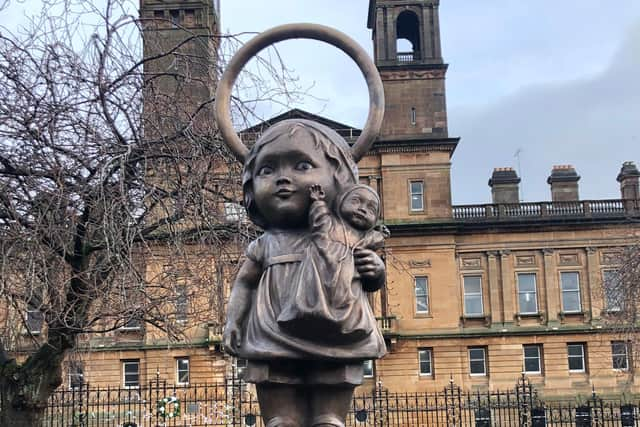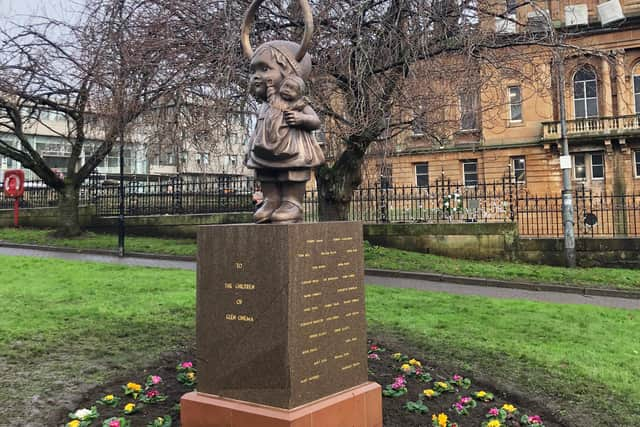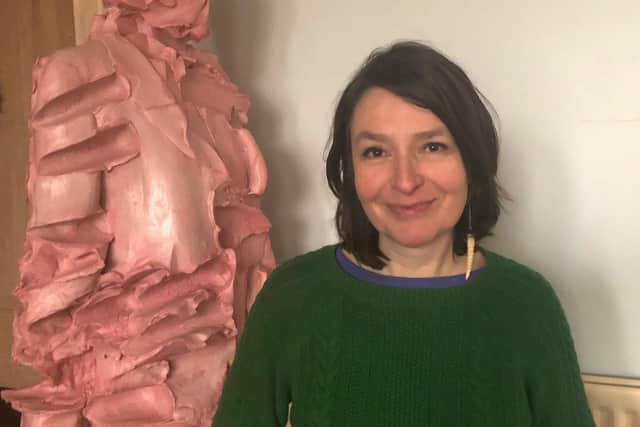Statue erected in tribute to children who died on Black Hogmanay, in Scotland’s worst human disaster
and live on Freeview channel 276
It has been erected as a tribute to what is still considered the worst human disaster on Scottish soil, when 71 children died after panic broke out over a suspected fire in a film theatre in Paisley.
The Glen Cinema Disaster occurred on December 31, 1929 and to this day is known as Paisley’s Black Hogmanay.
Advertisement
Hide AdAdvertisement
Hide AdFor the past 20 years members of the local community and families caught up in the disaster have gathered on the anniversary to remember those who perished.


But until now there has been no permanent memorial for the victims and survivors in the town centre.
The new installation, which depicts a doll-like figure clutching a baby, set against a symbolic out-sized child’s rattle from the time, has been erected in Dunn Square, across the road from the former cinema.
Entitled Rattle/Little Mother, the sculpture was created by artists Rachel Lowther, who is based in Glasgow, and Kerry Stewart, originally from Renfrewshire, but now living in London.
Advertisement
Hide AdAdvertisement
Hide AdThe pair were commissioned to work with the local community on creating a suitable memorial as part of commemorations for the 90th anniversary of the tragedy.


They created the emotionally arresting piece after meeting with survivors and relatives of the children who died.
It was funded by the Rotary Club of Paisley and Future Paisley.
Ms Lowther said it was “an absolute privilege” to work on the project, which marks such a significant and painful part of Paisley’s history.


Advertisement
Hide AdAdvertisement
Hide Ad“The tragedy pierced the heart of this community,” she said.
“Kerry and I were very aware of how easily that pain is felt again as we talked to different groups of people.
“A man told me his mother would have died after collapsing on that day, but the pain when someone stood on her face had brought her round.
“She managed to get to her feet and escape, but was left permanently disfigured. She literally carried the tragedy on her face.
Advertisement
Hide AdAdvertisement
Hide Ad“One woman told me her family lost three children, and another said her relative only survived because she hadn't done her chores and wasn’t allowed to go to the screening.
“We heard about a survivor who became phobic about going into buildings and ended up living on the streets.
“And lots of tales of children who survived, but were afraid they would be in trouble for losing a shoe or a cap or tearing their tights.
“It gives a picture of the times and the hardship many families lived in.
“These stories are crucial family legends.”
Advertisement
Hide AdAdvertisement
Hide AdAround 700 children, from babies to teenagers, had packed into the picture house for its matinee show on the final day of 1929.
No adults were on the premises and the projectionist was just 15.
Catastrophe struck when the auditorium began to fill with smoke, emanating from a smouldering film canister.
A total of 69 children were killed in the stampede for the exits, some of which were locked.
Advertisement
Hide AdAdvertisement
Hide AdAnother 40 were injured, with two more dying in the days that followed.
Most were crushed or trampled trying to escape, but some fell or jumped from the balconies.
A message from the Editor:
Thank you for reading this article. We’re more reliant on your support than ever as the shift in consumer habits brought about by coronavirus impacts our advertisers.
If you haven’t already, please consider supporting our trusted, fact-checked journalism by taking out a digital subscription.
Comment Guidelines
National World encourages reader discussion on our stories. User feedback, insights and back-and-forth exchanges add a rich layer of context to reporting. Please review our Community Guidelines before commenting.
